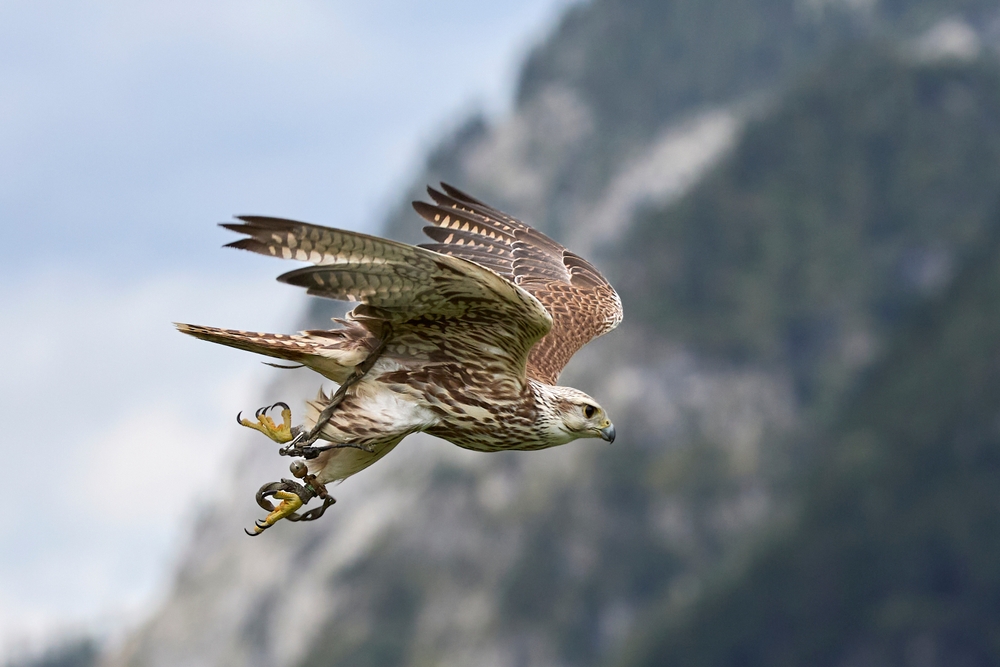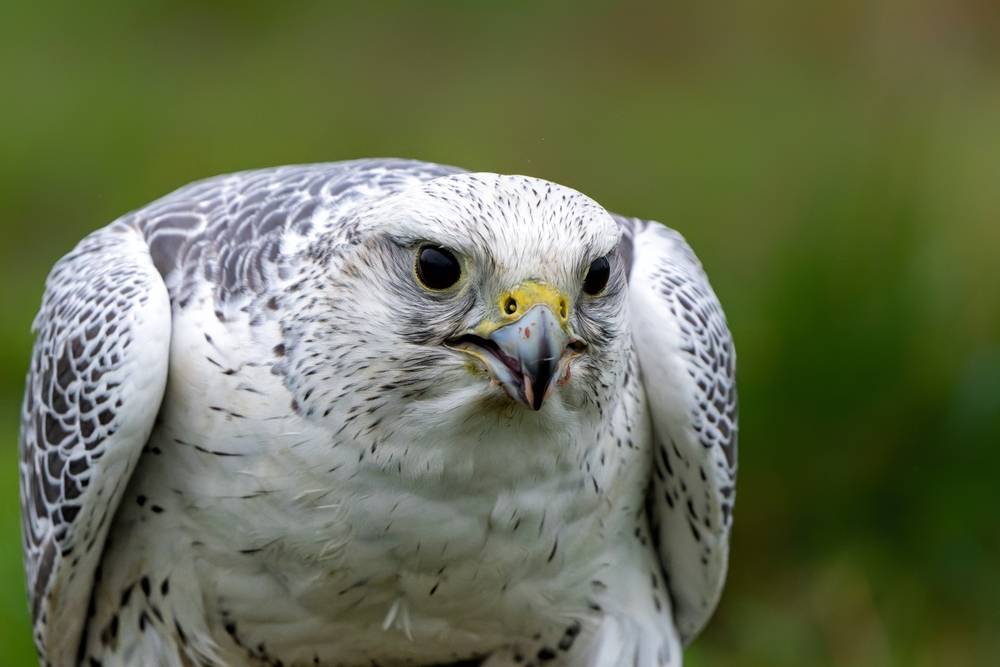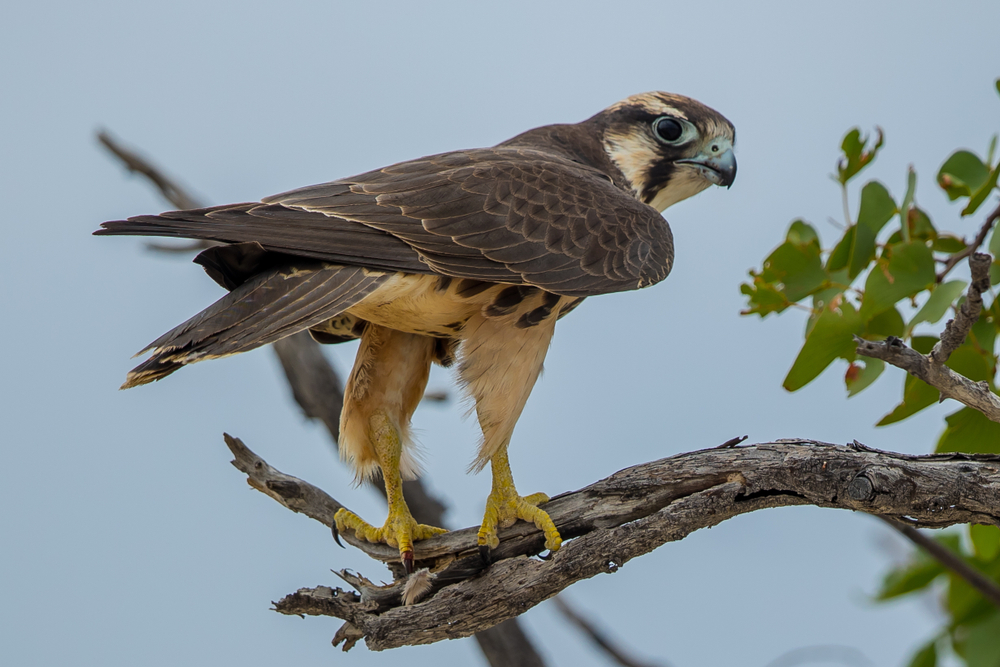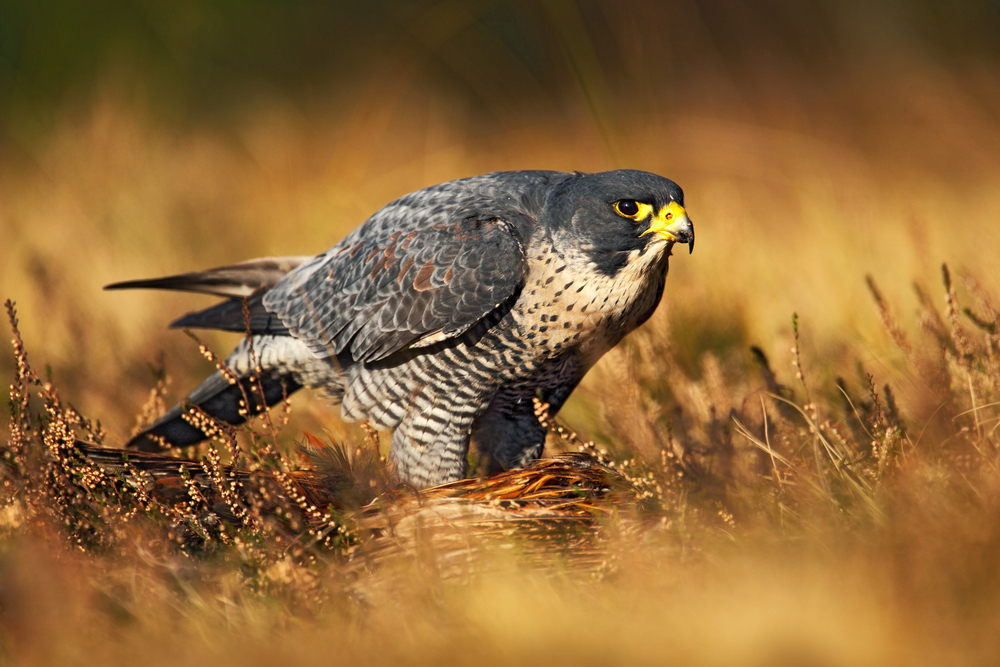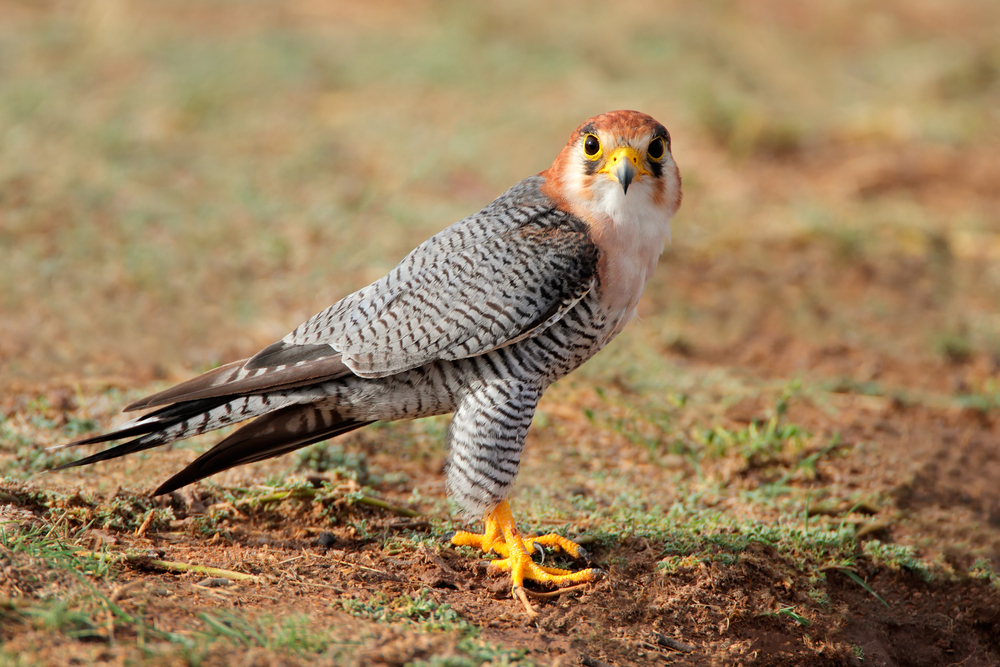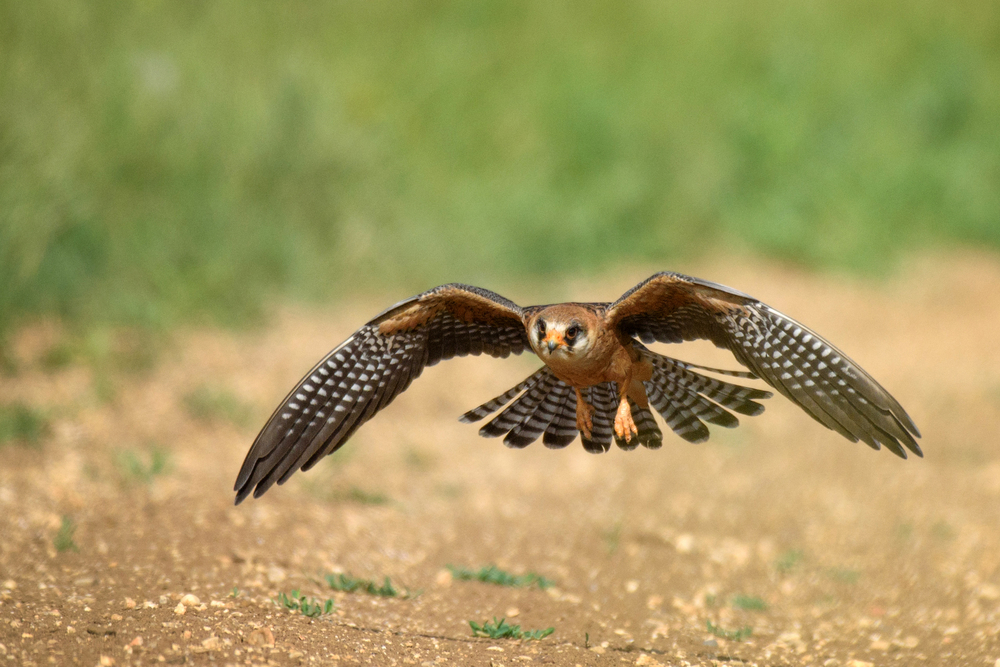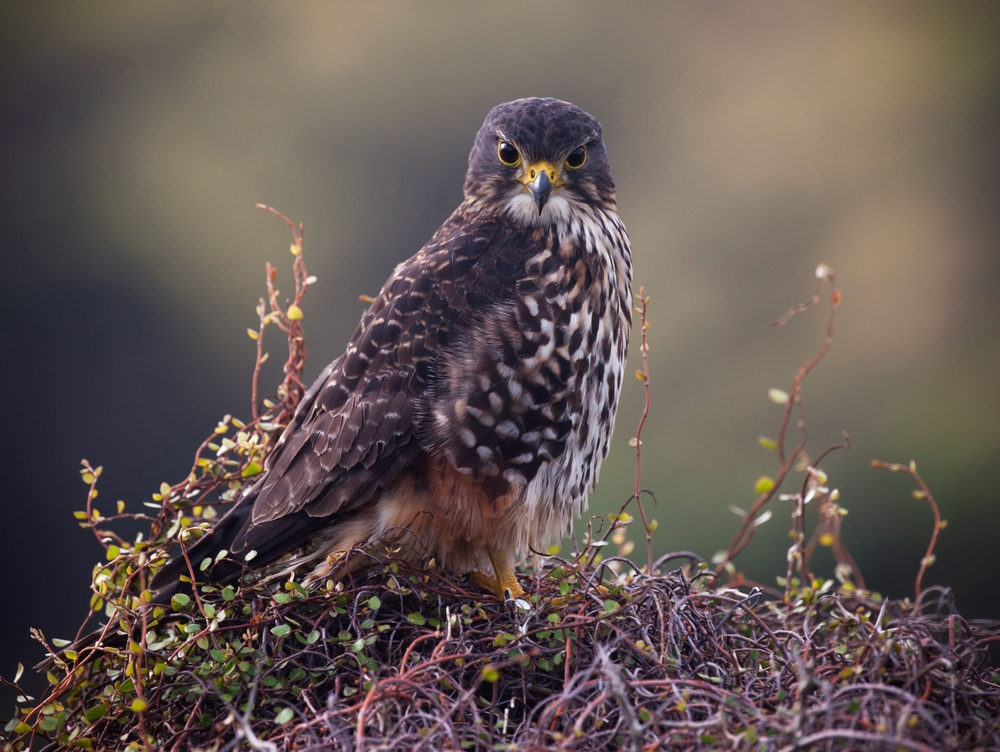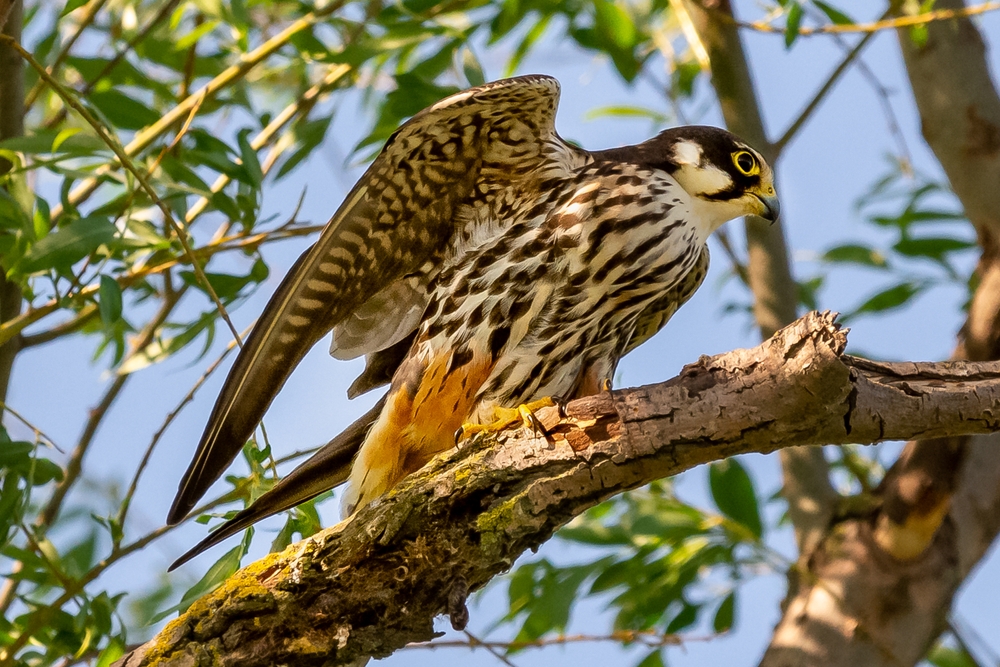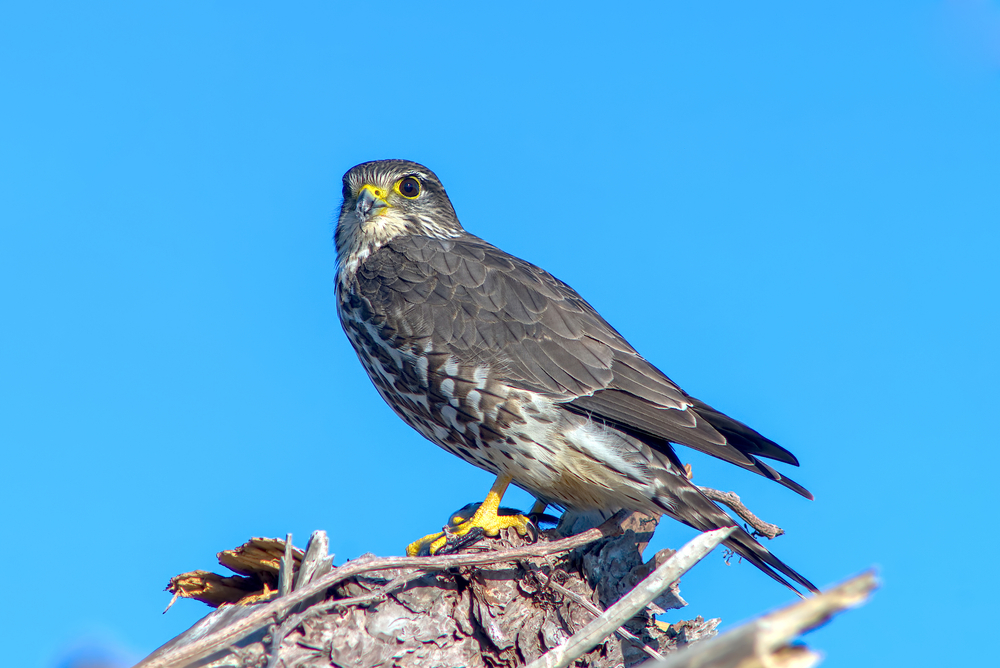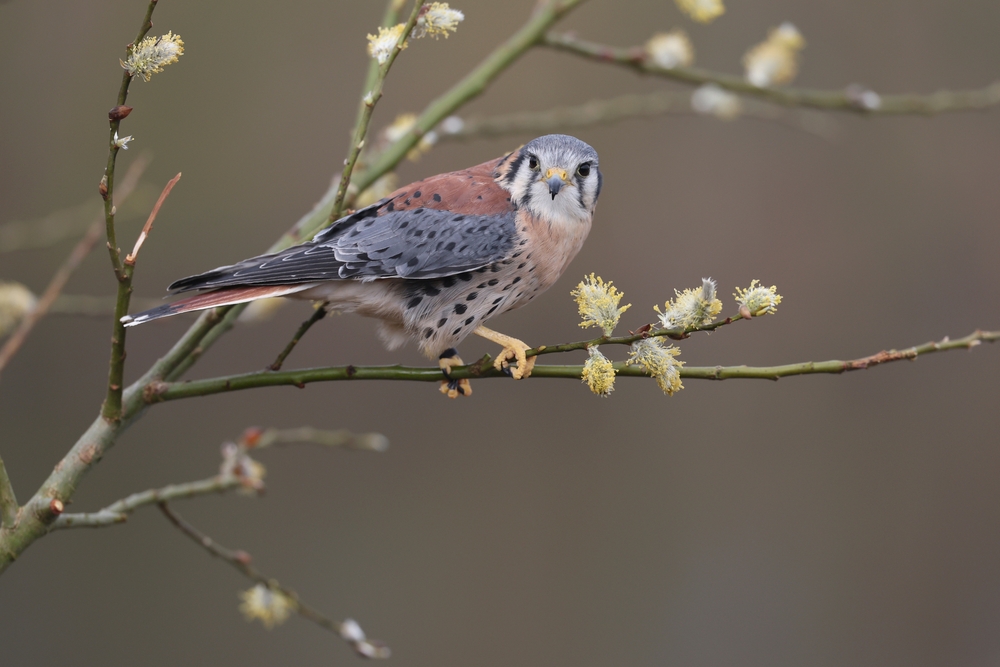The Saker Falcon (Falco cherrug) is most closely related to the Gyrfalcon (Falco rusticolus) and the Lanner Falcon (Falco biarmicus), both sharing similarities in size, strength, and open-country hunting styles.
About
The Saker Falcon (Falco cherrug), a member of the Falconidae family, is one of the largest and most powerful falcons in the world. Native to Eurasia, it inhabits open grasslands, steppes, and desert edges, stretching from Eastern Europe through Central Asia and into northern China. This species is revered both in the wild and in falconry, where it has been highly prized for centuries for its strength and hunting prowess.
The Saker Falcon is a robust bird, measuring 45–57 cm (18–22 in) in length with a wingspan of 105–129 cm (41–51 in). Plumage is highly variable, ranging from pale sandy-brown to dark chocolate, with streaked underparts and a characteristic pale head. This coloration helps camouflage the bird in dry, open habitats. Females are notably larger than males, a common trait among raptors.
An apex predator of the steppe, the Saker Falcon primarily hunts medium-sized birds such as pigeons, ducks, and corvids, as well as mammals like ground squirrels and hares. Unlike Peregrine Falcons, which often rely on high-speed stoops, Sakers specialize in horizontal pursuit, chasing prey with relentless stamina until they are brought down. Their strength and persistence make them formidable hunters.
Breeding typically takes place on cliff ledges, trees, or in old nests of other large birds. A clutch usually contains 3–6 eggs, with both parents actively defending their territory and raising their chicks. In the wild, reproductive success often depends on prey availability, which can fluctuate with environmental conditions.
For centuries, the Saker Falcon has held immense cultural significance, especially in Central Asia and the Middle East, where it is regarded as a noble falcon in traditional falconry. Today, however, wild populations face threats from habitat loss, prey decline, and illegal trapping for the falconry trade. Conservation efforts focus on habitat protection, captive breeding, and stricter international trade regulations.
Physical Characteristics
The Saker Falcon (Falco cherrug) is one of the largest falcons in the world, known for its powerful build, broad wings, and wide distribution across Eurasia.
Plumage:
-
Adults: Plumage varies from pale sandy-brown to dark brown, often with heavy streaking on the underparts. Upperparts are generally brown with lighter edges, giving a scaled appearance.
-
Head: Pale crown and nape with a contrasting dark “moustache” stripe, though less pronounced than in the Peregrine Falcon.
-
Juveniles: Darker overall, with heavier streaking on the breast and less contrast between head and body.
Head and Face:
The head is large with a pale crown and strong, hooked beak. The face is less boldly marked than Peregrines, giving Sakers a more uniform, hawk-like appearance.
Body and Wings:
The body is robust and muscular. Wings are broad, long, and slightly pointed, allowing both strong, sustained flight and powerful stoops. The Saker is built for endurance as well as bursts of speed.
Tail:
The tail is long, brown, and barred with darker bands, ending with a broader dark tip. It provides control during aerial pursuits and long-distance flight.
Size:
-
Length: 18–22 in (45–55 cm)
-
Wingspan: 41–51 in (105–129 cm)
-
Height at Rest: About 19 in (48 cm) when perched
Weight:
-
Adult Male: 1.5–2.2 lbs (700–1,000 g)
-
Adult Female: 2.2–3.3 lbs (1,000–1,500 g)
The Saker Falcon’s large size, pale crown, streaked underparts, and broad wings distinguish it from other falcons. Its combination of power and endurance makes it a dominant hunter across the steppes and deserts of Eurasia.
Reproduction
The Saker Falcon (Falco cherrug) breeds across the steppes, deserts, and mountainous regions of Eurasia, with a reproductive cycle adapted to open landscapes and prey availability.
1. Mating and Courtship:
Sakers are monogamous, often forming long-term pair bonds. Courtship includes aerial displays, high circling flights, and food passes, with males presenting prey to females as part of pair bonding.
2. Nesting Sites:
They do not build their own nests. Instead, Sakers reuse abandoned stick nests of crows, ravens, or eagles, often on cliffs, tall trees, or power pylons. In open steppe regions, they may nest on the ground or low outcrops.
3. Egg Laying:
The female lays 3–6 eggs per clutch, usually between March and May. Eggs are whitish or buff with reddish-brown markings.
4. Incubation:
Incubation lasts about 32–36 days, carried out mostly by the female, while the male provides prey and occasionally relieves her at the nest.
5. Hatching and Care of Chicks:
Chicks hatch covered in white down and are altricial. The female broods them closely in the first two weeks, while the male supplies food. As chicks grow, both parents share in feeding.
6. Fledging and Independence:
Young falcons fledge at about 45–50 days old. After fledging, they remain near the nest and continue to depend on their parents for several weeks as they learn hunting skills.
7. Breeding Frequency:
Saker Falcons typically raise one brood per year, though they may skip breeding in years when prey populations, especially ground squirrels and pigeons, are scarce.
The Saker Falcon’s reliance on old nests, large clutch size, and strong pair cooperation contribute to its reproductive success in the demanding steppe and desert habitats where it breeds.
Lifespan
The Saker Falcon (Falco cherrug) has a relatively long lifespan for a raptor, though survival is strongly influenced by prey availability, habitat conditions, and human pressures across its wide range.
Lifespan in the Wild:
In the wild, Saker Falcons typically live 12–16 years. However, many juveniles do not survive their first year due to predation, starvation, or accidents. The oldest known wild individuals may reach 18–20 years.
Lifespan in Captivity:
With steady food, veterinary care, and protection from hazards, Sakers can live up to 25 years in captivity, where conditions are far more stable than in the wild.
Threats to the Saker Falcon:
-
Prey Declines: Populations of ground squirrels and pigeons, key prey, fluctuate and directly affect breeding success.
-
Habitat Loss: Agricultural expansion and infrastructure development reduce nesting and hunting grounds.
-
Persecution & Trapping: In some regions, Sakers are trapped illegally for falconry, contributing to population declines.
-
Electrocution: Nesting and perching on power lines often result in accidental deaths.
-
Climate Change: Shifts in prey cycles and desertification impact long-term survival.
The Saker Falcon’s long lifespan, combined with its adaptability to steppe and desert environments, makes it a resilient species, though its survival depends on strong conservation action in regions where it is threatened.
Eating Habits
The Saker Falcon (Falco cherrug) is a powerful hunter of open landscapes, relying on speed, strength, and endurance to capture a wide range of prey.
Diet:
-
Birds: Primary prey includes pigeons, doves, sandgrouse, crows, and game birds such as partridges. In some regions, waterfowl are also important.
-
Mammals: Ground squirrels, hares, voles, and other small to medium-sized mammals are major food sources, especially in steppe habitats.
-
Other Prey: Occasionally take reptiles and insects, depending on availability.
Hunting Strategy:
-
Direct Pursuit: Unlike Peregrine Falcons, which stoop from great heights, Sakers favor sustained, level chases using powerful wingbeats to exhaust prey.
-
Ambush Attacks: May launch surprise strikes from perches, cliffs, or low flights over open ground.
-
Versatility: Capable of both aerial pursuits of birds and ground hunts for mammals, reflecting their adaptability.
Feeding Behavior:
-
Prey is dispatched quickly with a strong bite to the neck or head.
-
Small prey may be eaten on the spot, while larger prey is carried to a perch or feeding site for plucking.
-
During breeding, males provide prey for females and chicks, often delivering it directly at the nest site.
Success and Adaptability:
The Saker Falcon’s ability to hunt both birds and mammals makes it one of the most versatile raptors of Eurasia’s steppes and deserts. Its reliance on ground squirrels and pigeons, however, ties its survival closely to prey population cycles.
Uniqueness
The Saker Falcon (Falco cherrug) is a remarkable bird of prey, notable for its size, hunting style, and cultural significance.
One of the Largest Falcons:
The Saker is among the largest falcons in the world, second only to the Gyrfalcon, with females weighing over 3 lbs (1.5 kg). Its size gives it the strength to overpower larger prey.
Endurance Hunters:
Unlike Peregrines, which use steep high-speed stoops, Sakers specialize in long, sustained chases across open landscapes, relying on stamina and persistence rather than sudden dives.
Steppe and Desert Specialists:
Adapted to vast Eurasian grasslands and arid regions, the Saker Falcon thrives in environments where few large raptors dominate, hunting both ground mammals and flocking birds.
Cultural Importance in Falconry:
For centuries, Sakers have been highly prized in falconry across the Middle East, Central Asia, and Eastern Europe. Their power, endurance, and trainability make them legendary hunting partners.
Variable Plumage:
From pale sandy-brown to dark chocolate morphs, the Saker shows a wide range of plumage variation, often blending perfectly with steppe and desert surroundings for camouflage.
Conservation Significance:
The Saker Falcon is classified as Endangered, threatened by habitat loss, prey declines, and illegal capture for the falconry trade, making it a priority species for global raptor conservation.
The Saker Falcon’s combination of immense size, unique hunting endurance, and deep cultural heritage make it one of the most distinctive and admired falcons worldwide.
Be the First to Share Photos of This Species.
FAQ’s
1. What is the species closest to the Saker Falcon?
2. How does the Saker Falcon compare to other falcons?
The Saker is larger and heavier than the Peregrine Falcon, relying on stamina-driven chases rather than steep stoops. Compared to the Gyrfalcon, the Saker is slightly smaller and more adapted to steppe and desert habitats. Its plumage is more variable, often sandy-brown to blend into arid landscapes.
3. Which national parks provide the best opportunities to see a Saker Falcon?
Which national parks provide the best opportunities to see a Saker Falcon?
-
Hustai National Park (Mongolia): A key habitat in Eurasian steppe regions.
-
Korgalzhyn State Nature Reserve (Kazakhstan): Known for Saker nesting and hunting in open grasslands.
-
Danube Delta Biosphere Reserve (Romania/Ukraine): A European stronghold for breeding populations.
-
Altai Tavan Bogd National Park (Mongolia): Remote mountain-steppe areas where Sakers thrive.



































































